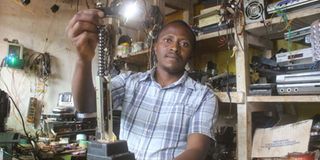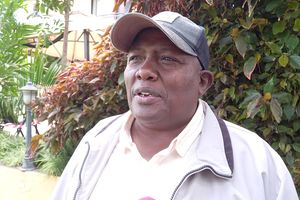Premium
Let’s tap e-waste revenue stream, not waste chance

Samuel Waithuki displays a reading lamp made from an old adapter and antennae at his workshop at Kiandu in Nyeri county on January 22, 2018. He is using e-wastes to make other gadgets for sale.
What you need to know:
- Kenya has made key milestones as well with various policies focused on e-waste.
- E-waste is an ‘urban mine’; it contains several precious, critical and noncritical metals that, if recycled, can be used as secondary materials.
E-waste are electronic products that are unwanted, not working and nearing or at the end of their ‘useful life’ and contain toxic additives or hazardous substances.
Increasing levels, low collection rates and non-environmentally sound disposal and treatment of this waste stream are risks to the environment and human health.
Last year, 53.6 million tonnes of e-waste were generated. However the fate of 44.3 million tonnes is uncertain since only 9.3 million tonnes was formally documented to have been collected and recycled.
Kenya has made key milestones as well with various policies focused on e-waste. They include E-Waste Guidelines 2010, draft E-Waste Regulations, National E-Waste Strategy 2019 and Draft Extended Producer Responsibility Regulations 2019.
Public assets
The Public Procurement and Disposal Act 2015 governs disposal of public assets in public institutions — including electronic and radioactive waste. But it is silent on the end-of-life effects electronic equipment.
With environment a devolved function, county governments should regulate waste management, which closely relates to several Sustainable Development Goals. Given the high raw material demand for the production of EEE, managing e-waste sustainably will be a catalyst to achieving the SDGs.
E-waste is an ‘urban mine’; it contains several precious, critical and noncritical metals that, if recycled, can be used as secondary materials. This is an opportunity to engage in the circular economy and reduce the pressure on virgin materials.
Recycling e-waste can help countries at least mitigate their material demand in a secure and sustainable way. The value of raw materials in the global e-waste generated in 2019 is equal to approximately $57 billion. Iron, copper and gold contribute mostly to this value. Four million tonnes of raw materials could be made available for recycling.
E-waste management
In many developing countries, Kenya included, e-waste management is done mainly by the informal sector players. It is a growing economic sector that generates millions of formal and informal jobs.
Kenyans are piling huge stocks of e-waste in homes, offices and other storage facilities. The national and county governments should enable broader participation in e-waste management.
They can partner with private firms through public-private-partnerships (PPP) to build robust and sustainable infrastructure to facilitate an environmentally friendly e-waste management system. Further, encourage all producers to create producer responsibility organisations to provide incentives for consumers to dispose of their WEEE. That include a take-back systems with a trade-in component.
Lastly, the government should provide local investors and private organisations with tax exemptions on e-waste recycling equipment and land on which to put up facilities and infrastructure. It should also develop incentives and guidelines that would motivate consumers to safely dispose of their e-waste.




